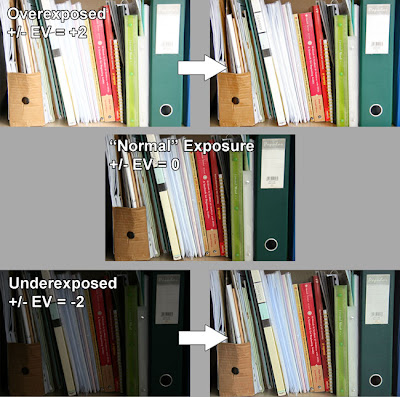Before this we have been dealing with image files coming directly from the camera, converted to JPEGs by the camera firmware and displayed on your computer monitor without user intervention. Somewhat akin to shooting slide film, where you have control only on the exposure but not the processing. Not being an expert of the digital darkroom, I shall only briefly talk about what I see as limitations of digital manipulation.
 Above is a set of 3 images, exposure bracketted to +/-EV = +2, 0 and -2 respectively. I have tried to turn the over- and uderexposed into the "well exposed" image using Adobe Photoshop. The scene has around 4 zones. From my placing of the white paper as zone VI, the zones range from V to VIII. From my earlier experiments, I know that my setup (camera + monitor) has 9 useful zones. Therefore in the +2 picture, some of the highlights would be blown out becuase what was zone VIII would now be zone X, i.e. completely white. In the -2 picture, the darkest parts would lie in zone III. Theoretically, you can "rescue" a region as long as it is not completely black or white and therefore the -2 image should be easier to rescue that the +2 image which really pushes the dynamic range of the camera. This is reflected in the processed images where some areas in the overexposed image are white and lack any detail despite my efforts. Extreme pulling of these areas give only patches of grey but not detail, whereas pushing of the underexposed image yields more and more shadow detail.
Above is a set of 3 images, exposure bracketted to +/-EV = +2, 0 and -2 respectively. I have tried to turn the over- and uderexposed into the "well exposed" image using Adobe Photoshop. The scene has around 4 zones. From my placing of the white paper as zone VI, the zones range from V to VIII. From my earlier experiments, I know that my setup (camera + monitor) has 9 useful zones. Therefore in the +2 picture, some of the highlights would be blown out becuase what was zone VIII would now be zone X, i.e. completely white. In the -2 picture, the darkest parts would lie in zone III. Theoretically, you can "rescue" a region as long as it is not completely black or white and therefore the -2 image should be easier to rescue that the +2 image which really pushes the dynamic range of the camera. This is reflected in the processed images where some areas in the overexposed image are white and lack any detail despite my efforts. Extreme pulling of these areas give only patches of grey but not detail, whereas pushing of the underexposed image yields more and more shadow detail.Reality, on the other hand, says another story. As with film, "pushing" (lightening a dark image) gives noise and grain, the extent was and still is proportional to the ISO used and the amount of pushing. Also note that the 3 types of sensors, red, green and blue, have different sensitivities (notwithstanding the additional fact that there are twice as many green sensors on a CCD than red or blue) which means that pushed images inevitably have shifted colours which may or may not be completely correctable. Also worth noting is that pushed shots tend to be flat unless you tweak the curves to add contrast.
What is more important than the technical intracacies is the feel of the image. It is not the purpose of this blog to tell you what looks good and what doesn't; that is for you to decide. The 3 images were taken on a rainy day. I tried to be honest and preserve the feeling of overcast difused lighting in the normal exposure, in the post processed shots, the pulled shot looks like it was taken under directional lighting while the pushed shot looks more like the "normal" exposure. I could have faked directional sunlight with that shot on a rainy day if it was my purpose.
One last thing about adding digital light is to know how much digital light you can add without getting unusable grainy images with strange colour casts. This matters a lot when you are forced to underexpose, e.g. to avoid camera shake in low light conditions. Knowing for example that you can safely move zone III to zone V gives you a standard to judge how much underexposure you can use. But remember that "pushability" relates to the actual exposure time (longer digital exposures have significantly more noise while this is not as significant for film), the ISO used and perhaps most importantly, what you use to process the image and the image format. RAW files are much more tolerant to post processing. With memory devices becoming cheaper by the day, shoot RAW always.
No comments:
Post a Comment